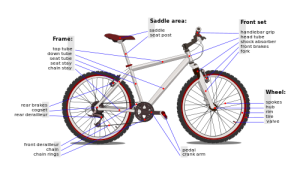Florida Still Deadliest for Bicyclists
If you’ve been following the 100th Tour de France, you will know it is nearing the final stages of the 23 day race. The Tour is a paragon of strength and endurance where the racers push themselves to unimaginable extremes, fighting through exhaustion, pain, and injury. It is nearly impossible not to feel inspired to get out on a bike after watching these racers.
But unlike the majority of us, the racers do not have to worry about biking on roads congested with automobile traffic.
For most of us, heavy traffic is simply a reality of life. In densely populated South Florida, paved or heavily used roads are often the only options for biking. As a result, there are an increasing number of motor vehicle related bicycle injuries and deaths. USA Today named Florida as the deadliest state for cyclists and walkers. According to the data from 2008, the most recent year of available statistics, 17.4% of all biking fatalities in the U.S. occurred in Florida.
Bicycle related fatalities are reported to be most common among adults. The reasons are simple. Biking is an enjoyable and cost effective way to exercise while getting outdoors. With the advent of bicycling groups, many enjoy the sport as much for its social benefits as for its cardiovascular ones. For those of us beginning to feel the effects of age, biking is easy on knees and joints. But a leisurely bike ride can quickly become fatal. In this year alone, Palm Beach County has reported five hit and run bicycle deaths.
In recent years, our firm has tried an increasing number of bicycle fatality cases, and while adults have the highest incidents of fatalities, children still face the same hazards posed by traffic. There is nothing more tragic than the loss of a child, especially when the death is preventable. Furthermore, children appear to have the highest risk of injury. A 2001 Center for Disease Control (CDC) report indicated that children 15 years and younger accounted for 59% of all bicycle-related injuries seen in US emergency departments.
This is not to say that no steps have been taken to combat these injuries and fatalities. Since 2001, Florida has worked to prevent future fatalities by building hundreds of miles of bike lanes. Although only those 16 and under are required by law to wear helmets, all Florida agencies encourage bicyclists to wear helmets.
Unfortunately, a recent study done by the University of Buffalo found that in accidents between motor vehicles and bicyclists, the use of bicycle lanes mattered less in determining the severity of the accident than the speed of the vehicle and the day light present.
If even our safety precautions are failing us, however, then what are the options left to us? Are we to simply abstain from such an enjoyable activity simply because of safety precautions? It’s obvious that that is neither a practical nor reasonable response. Instead, here are some suggestions to make biking as safe as possible. You’ve probably heard to always wear a helmet and to follow the law, so we’ll skip to advice you may not have heard:
- Ride illuminated Make yourself as visible as possible to all motorists by putting lights on the front and back of your bike, and wear reflective vests and neon colors. Most importantly, try to ride during the day when your visibility will be highest.
- Signal your turns. Learn and use hand signals to indicate your intended direction. If you are riding with children, teach them to do the same. Even when you signal, look behind you and make sure there is no oncoming traffic.
- Ride with traffic and try to make eye contact with drivers. Too many bikers, especially serious ones, ride with their head down. Instead, keep your head up and look around. Making eye contact with drivers can help you determine their intent.
- Avoid busy streets when possible. If you are biking on a congested road with many intersections, ride slowly and pause before each intersection. If you are riding with children, have them ride as close to you as possible and stop before each intersection. If the child is a beginner, walk your bikes across busy intersections.
- Do not hug the curb on narrow roads. If anything, use the whole street when appropriate. Riding closer to the center of the road prevents you from riding into an opening car door, as well as improves your visibility. At intersections, it also gives cars in the distance a better chance at seeing your approach. Contrastingly, stay a reasonable, but closer distance to the curb or use the sidewalk on busy roads.
Share This



